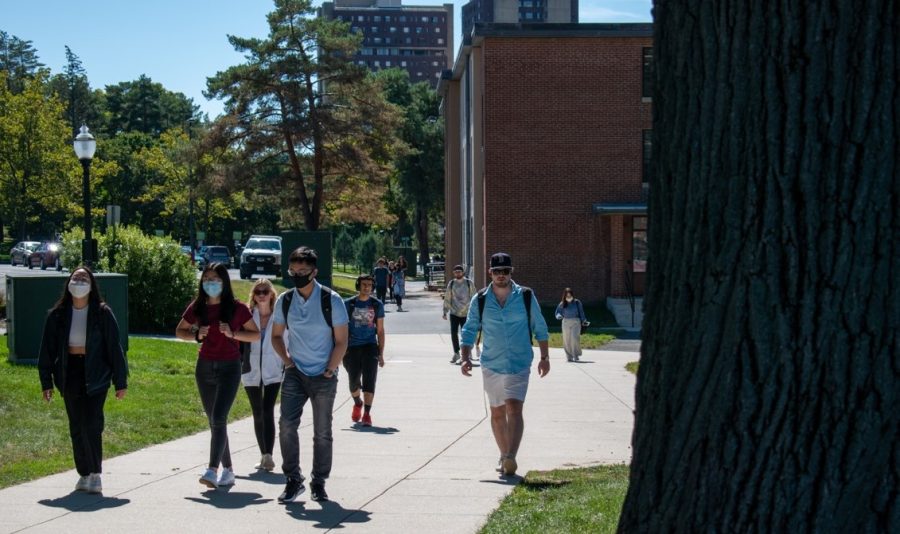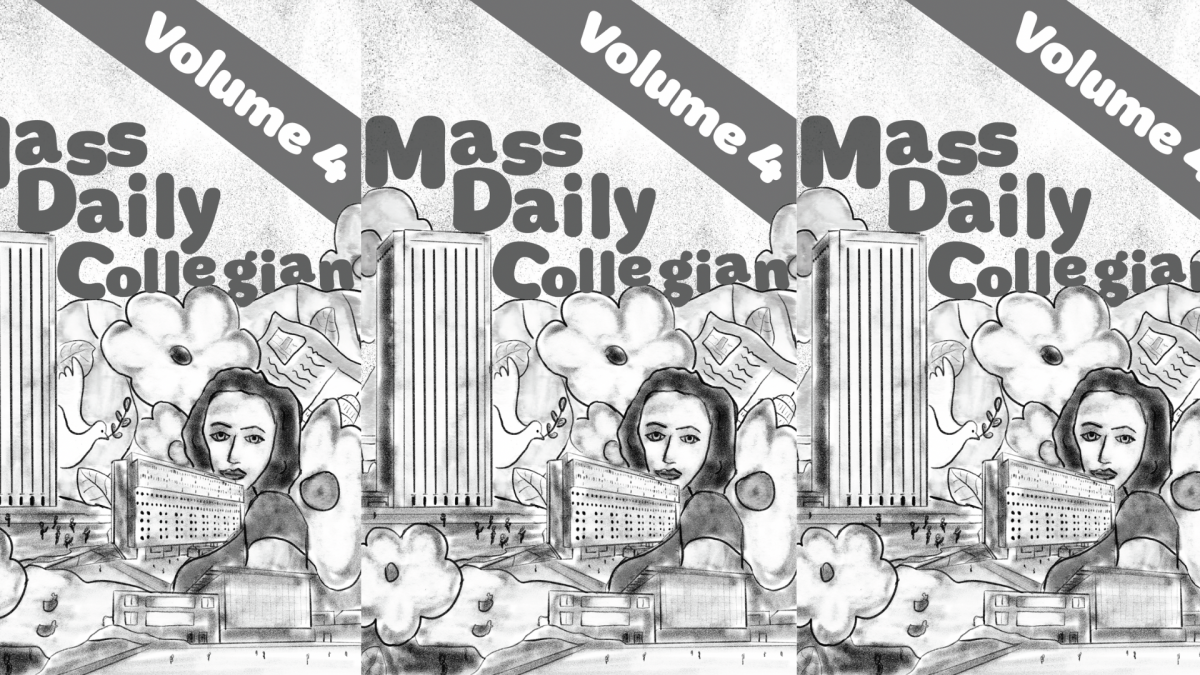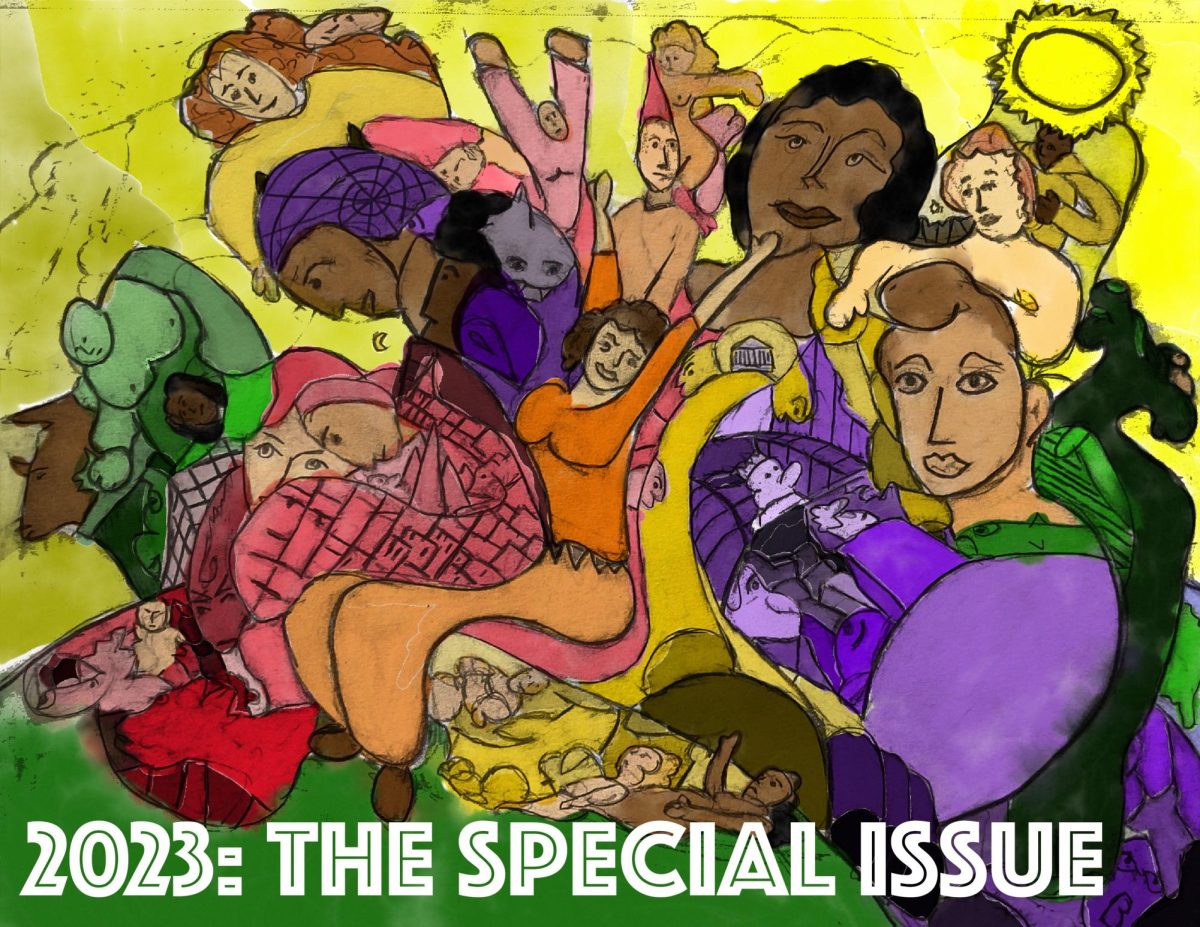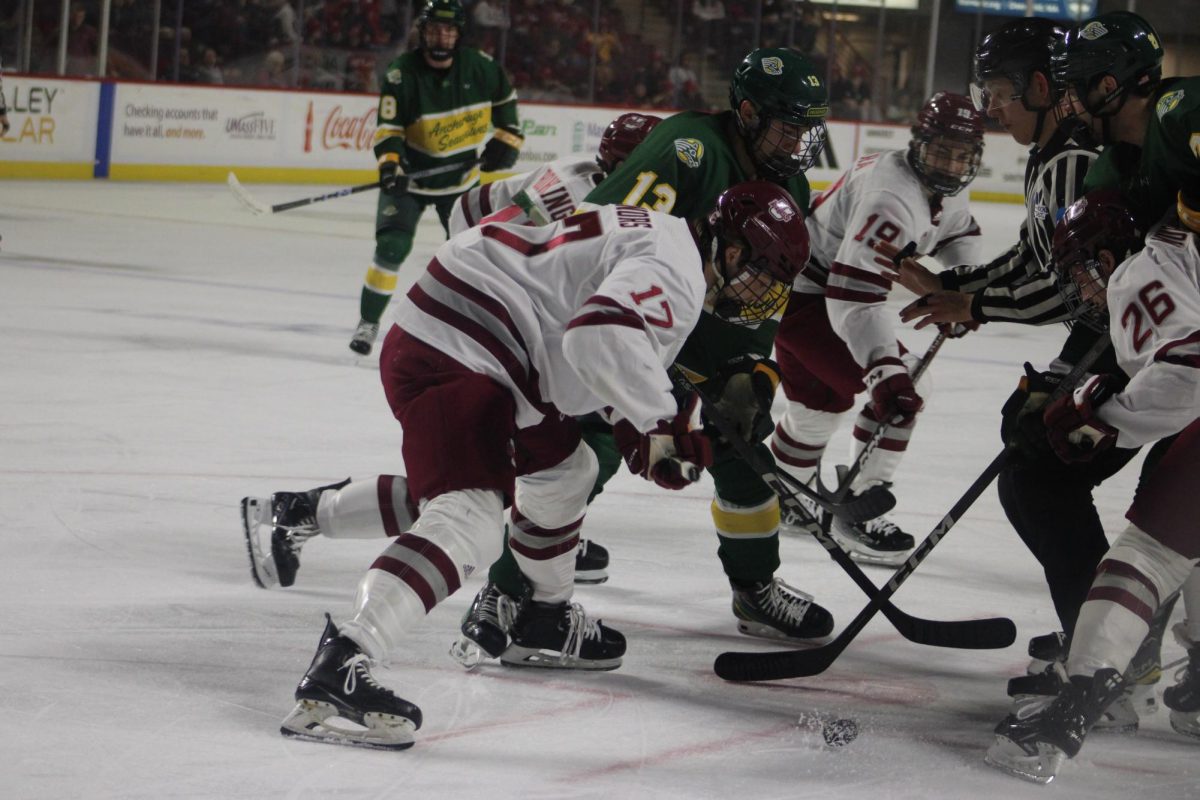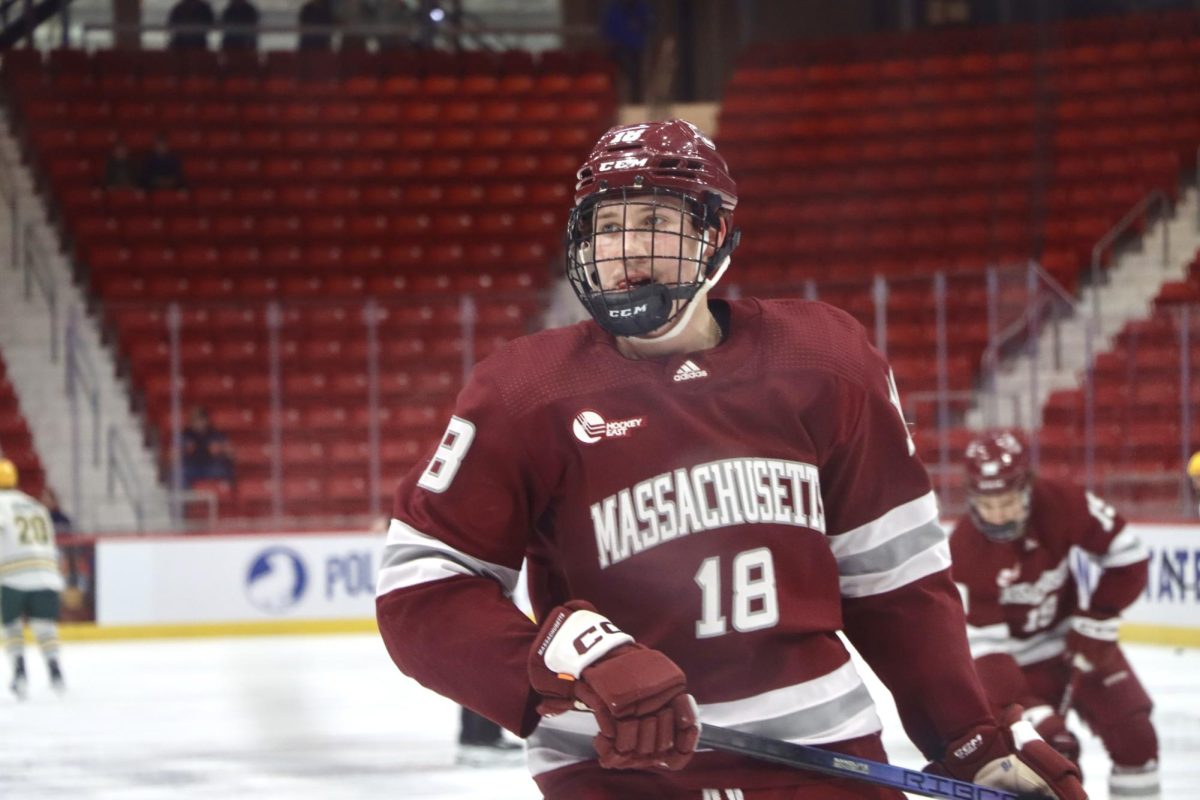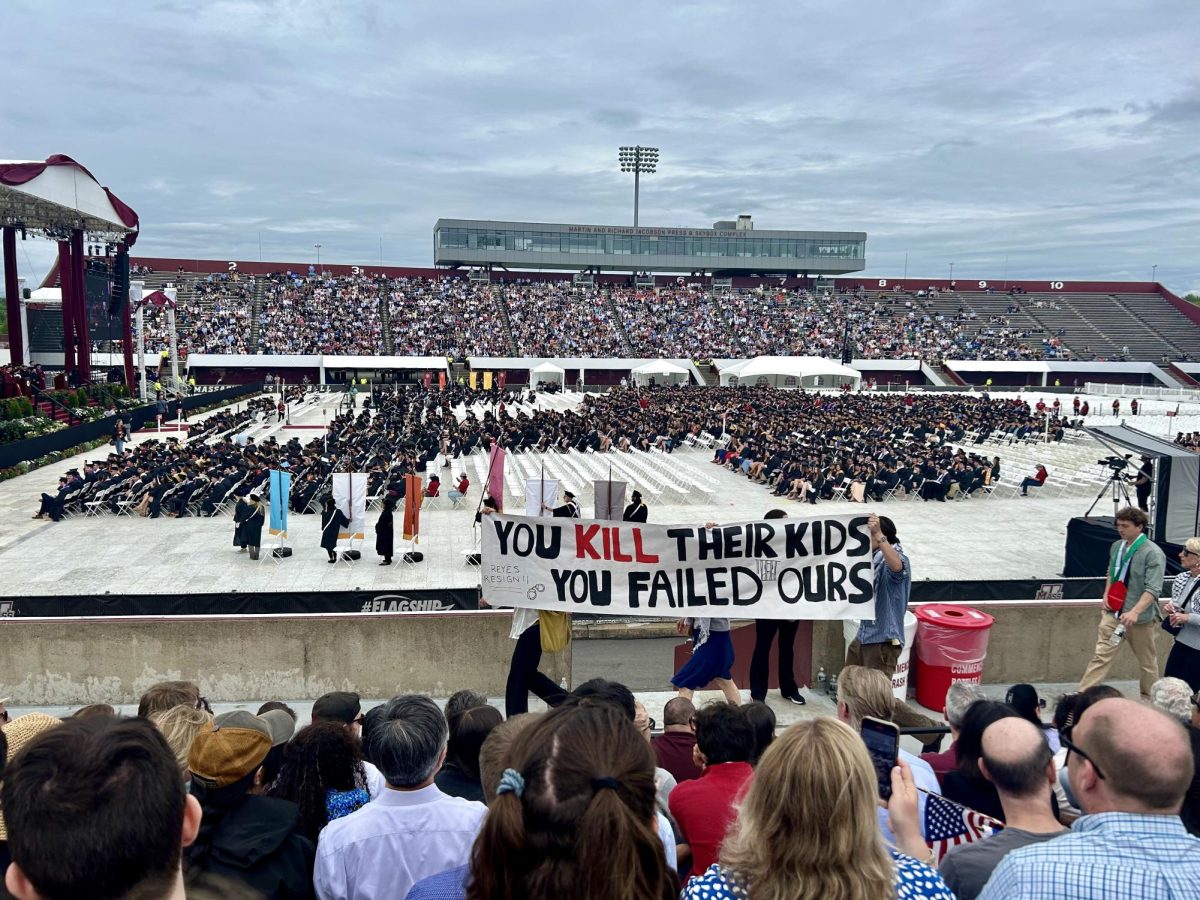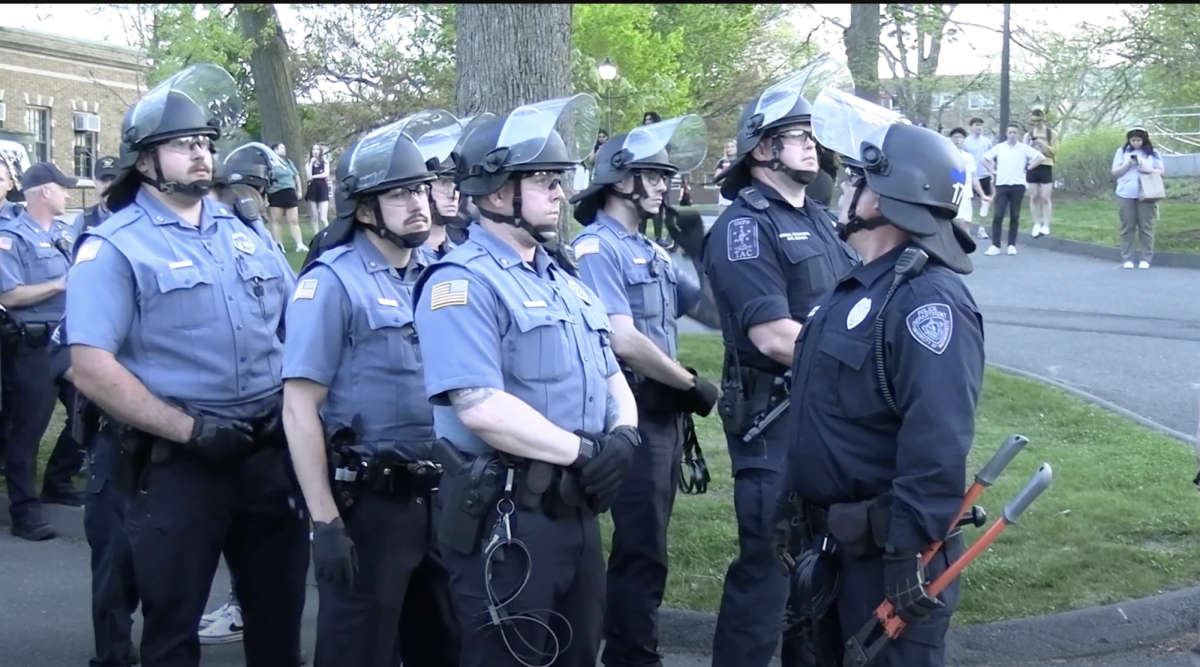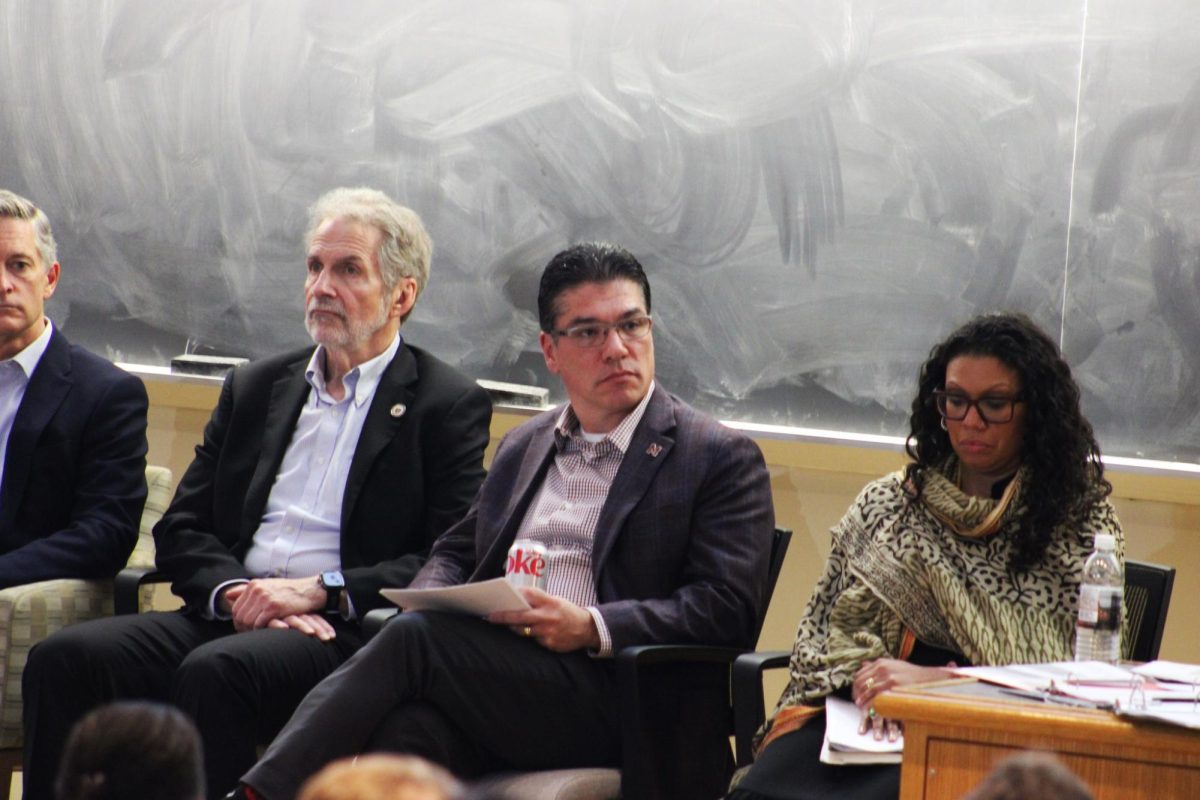Brianna Shepherd was understandably nervous as a sophomore on the front lines of a national effort to curb the COVID-19 pandemic. In the winter of 2021, Shepherd was administering COVID vaccines at the University of Massachusetts.
“It was my first time wearing my scrubs. It was my first time putting on my little name badge that said ‘Brianna’ and ‘Student Nurse’ under it. And I was probably shaking.”
Now a senior nursing major, Shepherd’s very first clinical experience was vaccinating community members in the town of Amherst.
“It was nerve-wracking for sure. They had a whole like morning course about how to actually give the vaccines and we had to read a whole bunch of paperwork and all these guidelines and everything. And I remember prepping so hard for this day,” Shepherd said.
Shepherd also recalled a piece of advice given to her by her clinical instructor: “Whatever you do, don’t tell them this is your first vaccine. Because you’re nervous, you’re gonna make them nervous. If they ask you how long you’ve been doing this, you say, ‘I’ve been here all morning.’’’
Shepherd’s very first patient was not a UMass student, but an elderly woman who was immunocompromised. Ironically enough, the woman asked Shepherd the very same question.
“She sat in my seat and she asked me how long I had been doing this … because I guess I looked nervous,” Shepherd said. “And I was like, ‘I’ve been here all morning.’ And I gave the first vaccine.”
That day, Shepherd and her student cohort vaccinated about 40 to 50 people each.
“Once that chair was empty, they put another person in it. It became second nature after a little while,” Shepherd said.
Shepherd’s experience vaccinating community members was a cog in a much larger and more complex machine working to regulate COVID on a highly populated campus.
A Look Back at COVID-19 at UMass
The University’s study abroad program was the first to be affected by the incoming pandemic. Study abroad in Italy was suspended as international travel warnings were enacted. But this international problem turned domestic as discussion surrounding online learning began. The anticipation for a temporary move to remote learning was short lived, though.
On March 13, 2020, the infamous letter from Chancellor Kumble Subbaswamy announcing that students would have to leave campus and enact a complete transition to online learning until the end of the semester circulated throughout the UMass community.
Mandy Muller is an assistant professor in the microbiology department who has been at the University for over five years.
“[The virus] kind of surprised us all by how fast it went around, how quickly it infected so many people and how easily it went from circulating in animals to circulating in humans, which is this critical step of spill over,” she said.
A little while after that unfortunate announcement, UMass’s first confirmed case of the novel coronavirus from a Blue Wall employee was announced on April 5, 2020.
Flash forward to June 29, 2020. The University revealed its Fall 2020 reopening plan that would allow students back on campus under “exacting public health restrictions.” However, the hope for a seamless return to campus faded as the pandemic nationally worsened.
On August 6, 2020, UMass announced a reversal to its previous plan, allowing only on-campus students that enrolled in “essential face-to-face classes.”
Contact Tracing: The key to preventing future clusters
With the introduction of students in the Fall of 2020 came the implementation of contact tracing, a public health practice used by the University to notify and identify people who have been exposed to the infectious disease.
Teah Snyder is an epidemiology PhD student who was also a contact tracing manager at UMass during the height of the pandemic. Because her lab group were the only graduates with expertise in infectious disease, they were asked to join the contact tracing effort as team leads meant to instruct undergraduate contract tracers.
With seven to 10 undergraduates contact tracing, two team leads and a manager on any given shift, about 45 people were hired a semester, according to Snyder.
Snyder gave insight into why she took on the role of team lead and eventually manager in Spring 2021.
“I know a lot of people, especially public health people, really kind of felt helpless, like they couldn’t help very much,” Snyder said. “And so, it was definitely a position that I felt was really needed that I could, as a public health professional, give back to the community.”
As manager, Snyder was tasked with training new hires, making schedules and creating the scripts that contact tracers had to follow to get the correct information from people exposed to the virus.
Questions asked included: “Where have you been in the past few days?” and “How did you interact?”
These questions also helped to determine possible cluster events that her team could address and get ahead of.
As the knowledge about the virus evolved, recommendations were constantly being revised. Snyder noted that the quarantine regulations would shorten throughout time, affecting the scripts that the contact tracers would have to follow.
Snyder recalled an especially overwhelming time during the Spring 2021 semester. The University experienced a drastic increase in COVID cases, leading to the campus experiencing a lockdown, reporting 394 active cases by February 2021.
Snyder’s team could not handle the number of incoming cases and half of her team was new and therefore untrained, which created an extra challenge. Transitioning between two online platforms used to record cases, their efficiency was also strained.
“It got really, really messy,” Snyder said. However, despite the challenges, she appreciated the concerted effort of the campus community to tackle such a challenge.
The Mullins Center: The home base of COVID-19 testing
Paired with UMass’ contact tracing efforts was the rollout of testing in the fall of 2020. The Mullins Center, which was built to be a sport and entertainment complex, was transformed into a testing center over the summer of 2020 for students, the Amherst community and surrounding towns.
Ann Becker, a clinical associate faculty in the Elaine Marieb College of Nursing and the public health director at UMass was a well-known figure tied to UMass’s COVID response effort.
“We spent that summer really ramping up our staffing really quickly, to be able to test thousands of people every week,” Becker said.
When the testing process was in its infancy, UMass Nursing students were present to help “beta test” the program, according to Becker.
Executive Director of Environmental Health and Safety and Emergency Management Jefferey Hescock was alongside Becker at the forefront of UMass’s pandemic response as well.
According to Hescock, UMass sent their COVID test samples to the Broad Institute to be analyzed. By the spring semester, the Institute for Applied Life Sciences received a state grant allowing for samples to be sent to the on-campus lab. This opened up testing to the community and enabled a quicker response for positive tests.
Sophie Meltzer, a senior nursing student with a dual degree in Spanish, worked as an asymptomatic tester from January to May of 2021. Working about 12 hours a week, Meltzer registered student information and instructed people how to test themselves.
When asked why she joined the testing team, Meltzer felt that this was her way of contributing to the University’s effort.
“I didn’t just want to sit by and kind of let it go past me. Because while the frontline workers were working, I was like, oh, dang, I’m so close to being there but I can’t help you yet. So that was kind of my way to get involved in and help out where I could,” she said.
Once the testing center migrated out of the Mullins Center, the University developed a creative way for the community to access testing kits. In October of 2021, vending machines containing test kits were placed in the Campus Center and Whitmore. Hescock said that to enhance public health, “out of the box thinking” is necessary.
A maybe less known process being used by the University is wastewater testing which began in the Spring of 2021. Traps set up in wastewater outlets in each building on campus collected samples that could be tested and indicate whether there are positive people in a particular dorm.
“With this system, they were able to mitigate outbreaks because the wastewater showed positivity several days before symptoms were able to come out,” said Wilmore Webley, associate professor of microbiology and senior vice provost for equity and inclusion.
Vaccinations: The final piece in a complex puzzle
With the introduction of the University’s vaccine clinic in January of 2021, the clinic needed aid to vaccinate such a large community.
The nursing program curriculum includes students participating in clinical hours. Due to the lack of clinical sites open because of the pandemic, work at the vaccine clinic was offered to nursing students. Brianna Shepherd was one of the students stationed at the clinic.
Before they could vaccinate the community, the students had to vaccinate and test each other. “That was our very first clinical experience,” Shepherd said.
For two years, twice a week, Shepherd was in the vaccine center both administering 50 to 60 vaccinations a day and drawing up the vaccines from vials sent to the campus. Shepherd also noted a challenge that occurred when getting the vaccines out to people.
“It would take more time to draw up the vaccine than it would take to give the vaccines,” Shepherd said. “So, we were really running into this wall of needing to move faster at drawing up the vaccine in order to vaccinate enough people.”
Knowing the dire need of the community to get the vaccine, Shepherd felt the weight of her responsibility.
“There’s a lot of people that during the early times of COVID that were really desperate for the vaccines,” Shepherd said. “So, Ann Becker expanded the force incredibly and it was awesome.”
Becker said that over the first year to year and a half, around 50,000 vaccines were given.
Student involvement: The backbone of UMass’s outbreak response
Jeff Hescock described the University’s initial response to COVID as a three-legged stool, meaning that the effort was supported by testing, contract racing and quarantining. The introduction of vaccinations was the fourth leg needed, but he said that behind this ambitious effort was the 90 percent student staff.
“The success of the campus was based on our students,” Hescock said. “It was nursing students there watching you swab your nose. And then it was our public health students who are doing contact tracing, case investigations [and] putting you in isolation.”
Becker was also grateful for the student effort. “The students were amazing. They were so helpful, and they brought in such energy. It was just … it was great,” she said.
Snyder noted the benefit of having student contact tracers talk with other students: “Typically there was a lot more trust there, people understood each other, and I think that worked really well.”
Communicating COVID-19
Throughout the pandemic, the UMass community was sent update upon update as policies constantly changed. The Public Health Promotion Center, which was created during the pandemic, collaborated with the UMass News and Media Relations Office to send out weekly memos and campus alerts. Becker and Hescock’s names were seen at the bottom of every email.
UMass was also in constant contact with the State Department of Health and would look for their guidance before making policy decisions. Hescock would also observe the outbreak responses of schools such as Boston University and Indiana University as well as the Five Colleges when making decisions regarding protocol.
However, Shepherd believes that minimizing panic at the pandemic’s early stages was a particular challenge for the University.
“I feel like leaving the students in the dark for so long was not necessarily what I would consider the best option from a student perspective. And I think from an admin perspective, someone who doesn’t necessarily live on campus, someone who doesn’t have all of their stuff slammed in a dorm 21 flights up in Kennedy isn’t necessarily thinking about, ‘How am I going to get home,’” Shepherd said.
The 2017 Meningitis Outbreak
While the COVID-19 pandemic is the most recent outbreak to hit UMass under Subbaswamy’s leadership, there was an outbreak of meningitis on the campus in 2017. Because of the deadliness and contagiousness of Meningococcal B, two cases were considered an outbreak.
This led to a mass double-dose vaccination of the campus. The old Student Union was transformed into a vaccine clinic where over 10,000 vaccinations were conducted, according to Hescock.
While this outbreak effort was mainly targeted towards students and did not interrupt the operations of the University, the use of mass vaccination sites, efficient communication, contact tracing and the creation of a directive website for meningitis were all strategies used again in 2020.
Muller commented on how UMass’s response to these two viruses compared.
“Even if you know the bug that’s making you sick is very different, the best way to protect yourself from it is to get this protective dose before you’re even infected. In that regard, the way you approach those two things should be similar,” Muller said.
UMass’s History with Emergency Preparedness
Surprisingly, UMass does not fall under direct jurisdiction of the town of Amherst when it comes to public health. The University actually has its own public health department and instead works more collaboratively with the town.
“[It] gives us a lot of flexibility in terms of running the campus the way that we need to support our students,” Hescock said.
Becker recalls the conversation regarding outbreak control starting in 2002 during the global SARS outbreak. “So, I’ve been having those conversations for over 20 years here on campus,” she said.
In regards to communication and emergency response, Hescock referred to the mass shooting at Virginia Tech in 2007. “The text messages, the sirens, like a lot of that stuff was kind of new to higher ed … across the national landscape,” Hescock said.
Leading up to the meningitis outbreak, Hescock noted that large-scale emergency preparedness exercises had already been conducted, and that collaboration with the College of Nursing was nothing new.
Right before the pandemic, Becker was cautious of a measles outbreak during the summer of 2019 and into the fall. Tabletop exercises were held where campus administrators convened and discussed what action to take and how to proceed with a response.
“So we had just been doing those sorts of planning and then this new threat came upon us and we started that same process,” Becker said.
When it came time to combat COVID, emergency preparedness, interdepartmental collaboration and student involvement were far from taboo.
“These relationships you just can’t do March 2020 and then be able to have kind of a response. It really requires this solid relationship building over a long period of time,” Becker said.
The rise of mental health awareness in higher education
Across the country, higher education has begun to address the mental wellbeing of students. Elizabeth “Betsy” Cracco is the current assistant vice chancellor for campus life and wellbeing. Cracco joined UMass faculty in 2019.
“Mental health, like physical health, is something that we all have. Like physical health we have to do things to help it be okay,” Cracco said. “In order for students to do well, academically, they have to also be well emotionally, spiritually, physically.”
Some programs that have been instituted at UMass include Positivity and Relaxation Training and Stress to Strength classes which are two nine-to-10-week two credit classes. During the pandemic, Wellbeing Wednesdays were also introduced in order to help students cope with anxiety and stress. The pond fires that were held when students were brought back to campus were a part of this effort to help students feel connected in a time where there was a lack of.
After Chancellor Subbaswamy signed off on the Okanagan Charter in October 2022, Cracco aimed to change the culture of the UMass student body. When she began work at the University, the JED Campus project was instituted. The program is a four-year initiative around mental health and wellbeing, according to Cracco.
“I think the era of just sort of like one-time educational programs is shifted to this more sustained engagement,” Cracco said.
Cracco emphasized the importance of preserving mental health due to the lasting effects of the COVID-19 pandemic. “[The pandemic] created a shifting landscape, I guess, I would say when it comes to mental health, right, so increases in anxiety, increases in social anxiety, increases in academic anxiety, distinctly.”
“People are more willing to talk about these things around mental health. I think it’s really because people are not okay. You know, the suffering is real,” Cracco said when asked why there may be a recent emphasis on mental health nationally.
Jack Underhill can be reached at [email protected] and followed on Twitter @JackUnderhill16.

